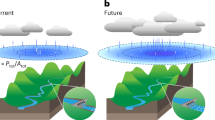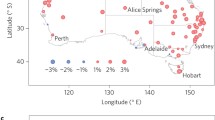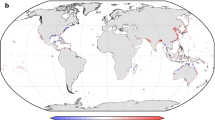Abstract
Ice storms can produce extensive damage to physical infrastructure, cause deaths and injuries, and result in large losses through business interruption. Total costs can be billions of dollars. If society is to increase its resilience to such events, we need a better understanding of the likely frequency, intensity and geographical distribution of ice storms. Unfortunately, due to competing temperature and precipitation effects as well as surface effects, it is unclear how climate change will affect the frequency, intensity and geographical distribution of ice storms. Here we perform a simple “thought experiment” using vertical temperature profile data to explore how these might change given plausible future temperature regimes. As temperatures increase, we find a poleward shift and a shift toward winter. Furthermore, southern locations experience fewer ice storms at all times of the year, while northern areas experience fewer in the spring and fall and more in the winter. Using an approximation for surface effects, we estimate that a temperature increase will result in an increased frequency of ice storm events throughout much of the winter across eastern Canada and in the U.S. west of the Appalachian Mountains as far south as Tennessee. Future changes in variability may enhance or moderate these changes.







Similar content being viewed by others
Notes
Please recall that we enacted a uniform temperature increase across all areas as opposed to differential heating in different places as might be expected from a globally averaged temperature change. For this reason the results should be interpreted only as changes in local temperature changes and not as a globally averaged warming.
For example, it is unclear whether a Scenario A temperature increase of 2 °C would be equivalent to a Scenario B temperature increase of a) 4 °C above 850 hPa and 2 °C below 850 hPa (match the surface temperatures), b) 2 °C above 850 hPa and 1 °C below 850 hPa (match the temperatures above 850 hPa), or c) 2.66 °C above 850 hPa and 1.33 °C below 850 hPa (match an average temperature).
References
Ahrens CD, Samson P (2011) Extreme weather & climate. Belmont, Brooks/Cole, Cengage Learning
American Meteorological Society (2014) “Ice storm”. Glossary of meteorology. Last accessed July 7, 2014. http://glossary.ametsoc.org/wiki/Ice_storm
Baldwin M, Treadon R, Contorno S (1994) Precipitation type prediction using a decision tree approach with NMC’s mesoscale Eta Model. Preprints, Tenth Conference on Numerical Weather Prediction, American Meteorological Society 30–31
Bourgouin P (2000) A method to determine precipitation type. Weather Forecast 15:583–592
Campbell RJ (2012) Weather-related power outages and electric system resiliency. Congressional Research Service. Report 7–5700, R42696, 18 pp
CBSNews (2014) Four Deaths Blamed on Ice Storm. Last accessed July 7, 2014. http://www.cbsnews.com/news/four-deaths-blamed-on-ice-storm/
Changnon SA, Changnon JM (2002) Major ice storms in the United States, 1949–2000. Environ Hazards 4(4):105–111
Cheng CS, Auld H, Li G, Klaassen J, Li Q (2007) Possible impacts of climate change on freezing rain in south-central Canada using downscaled future climate scenarios. Nat Hazards Earth Syst Sci 7:71–87
Cheng CS, Li G, Auld H (2011) Possible impacts of climate change on freezing rain using downscaled future climate scenarios: updated for Eastern Canada. Atmosphere-Ocean 49(1):8–21
Cortinas JV, Bernstein BC, Robbins CC, Strapp JW (2004) An analysis of freezing rain, freezing drizzle, and ice pellets across the United States and Canada: 1976–90. Weather Forecast 19:377–390
Czys RR, Scott RW, Tang KC, Przybylinski RW, Sabones ME (1996) A physically based, nondimensional parameter for discriminating between locations of freezing rain and ice pellets. Weather Forecast 11:591–598
Druez J, McComber P, Farzaneh M (1999) Correlation between measurement of an ice detector and the mass of ice accreted on two different sized conductors. Can J Civ Eng 26(6):869–875
Fu Q, Manabe S, Johanson CM (2011) On the warming in the tropical upper troposphere: models versus observations. Geophys Res Lett 38, L15704
Hines P, Apt J, Talukdar S (2009) Large Blackouts in North America: historical trends and policy implications. Energy Policy 3:5249–5259
Holton JR (2004) An introduction to dynamic meteorology. Elsevier Academic Press, Burlington
Houston TG, Changnon SA (2006) Freezing rain events: a major weather hazard in the conterminous US. Nat Hazards 40:485–494
IPCC (2013) In: Stocker TF et al (eds) Climate change 2013: The physical science basis. Contribution of Working Group I to the Fifth Assessment Report of the Intergovernmental Panel on Climate change. Cambridge University Press, Cambridge, 1535 pp
Kovacik C A (2014) Preliminary climatology of U.S. ice storm frequency and a comparison between Northeast U.S. ice storm frequency and Teleconnections. M.S. Thesis, University of Oklahoma
Lambert SJ, Hansen BK (2011) Simulated changes in the freezing rain climatology of North America under Global Warming using a coupled climate model. Atmosphere-Ocean 49(3):289–295
Lanzante JR, Free M (2008) Comparison of radiosonde and GCM vertical temperature trend profiles: effects of dataset choice and data homogenization. J Climate 21:5417–5435
McKitrick R, McIntyre S, Herman C (2010) Panel and multivariate methods for tests of trend equivalence in climate data series. Atmos Sci Lett 11:270–277
Melillo JM, Richmond TC, Yohe GW (eds) (2014) Climate change impacts in the United States: The Third National Climate Assessment. U.S. Global Change Research Program, 841 pp. doi:10.7930/J0Z31WJ2
Mesinger F, DiMego G, Kalnay E, Mitchell K, Shafran PC, Ebisuzaki W, Jović D, Woollen J, Rogers E, Berbery EH, Ek MB, Fan Y, Grumbine R, Higgins W, Li H, Lin Y, Manikin G, Parrish D, Shi W (2006) North American Regional reanalysis. Bull Am Meteorol Soc 87:343–360
Miller FP, Vandome AF, McBrewster J (eds) (2011) January 2007 North American ice storm. Online: Alphascript Publishing. 64 pp. ISBN-13: 9786134349062
Millward AA, Kraft CE (2004) Physical influences of landscape on a large-extent ecological disturbance: the Northeastern North American ice storm of 1998. Landsc Ecol 19:99–111
National Weather Service Forecast Office: Burlington, Vermont (2014) 10th Anniversary of the Devastating 1998 Ice Storm in the Northeast. Last accessed July 7, 2014. http://www.erh.noaa.gov/btv/events/IceStorm1998/ice98.shtml
North Carolina Public Utility Commission (NCPUC) (2003) Report of the North Carolina Utilities Commission and the Public Staff to the North Carolina Natural Disaster Preparedness Task Force, Response of the Electric Utilities to the December2002 Ice Storm. Raleigh, NC. 74 pp. Available: http://www.ncuc.commerce.state.nc.us/reports/part1ice.pdf
Personal communication. NCEP North American Regional Reanalysis modeling group. October 2013.
Po-Chedley S, Fu Q (2012) Discrepancies in tropical upper tropospheric warming between atmospheric circulation models and satellites. Environ Res Lett 7, 044018. doi:10.1088/1748-9326/7/4/044018
Ramer J (1993) An empirical technique for diagnosing precipitation type from model output. In: Preprints 5th International Conference on Aviation Weather Systems. American Meteorological Society, Vienna, pp 227–230
Ressler GM, Milrad SR, Atallah EH, Gyakum JR (2011) Synoptic-scale analysis of freezing rain events in Montreal, Quebec, Canada. Weather Forecast 27:362–378
Santer BD et al (2013) Identifying human influences on atmospheric temperature. Proc Natl Acad Sci U S A 110:26–33
Shan L, Marr L, McCafferty RM (1998) Ice storm data base and ice severity maps. Atmos Res 46:159–168
Splawinski S, Gyakum JR, Atallah EH (2011) Atmospheric circulation structures associated with freezing rain in Quebec City, Quebec. McGill Sci Undergrad Res J 6(1):50
University of Wyoming (2014) Wyoming Weather Web. Last accessed: July 18, 2014. http://weather.uwyo.edu/
USAID (2014) A review of downscaling methods for climate change projections. U.S. Agency for International Development: Washington, DC. Available: http://www.ciesin.org/documents/Downscaling_CLEARED_000.pdf
Wong CJ, Miller MD (2010) Guidelines for electrical transmission line structural loading ASCE manuals and reports on engineering practice No. 74. doi:10.1061/9780784410356
Acknowledgments
We thank the Carnegie Mellon Electricity Industry Center and the Center for Climate and Energy Decision Making (created through a cooperative agreement between the NSF (SES-0345798) and Carnegie Mellon. Also thanks for significant support and input from the University of Wyoming for providing the temperature soundings, from Professor John Gyakum of McGill for suggestions on the design of the non-uniform temperature increase experiment, and from Carnegie Mellon’s Patti Steranchak for reviewing the manuscript.
Author information
Authors and Affiliations
Corresponding author
Electronic supplementary material
Below is the link to the electronic supplementary material.
ESM 1
(PDF 750 kb)
Rights and permissions
About this article
Cite this article
Klima, K., Morgan, M.G. Ice storm frequencies in a warmer climate. Climatic Change 133, 209–222 (2015). https://doi.org/10.1007/s10584-015-1460-9
Received:
Accepted:
Published:
Issue Date:
DOI: https://doi.org/10.1007/s10584-015-1460-9




